Scaling Behavior of Peat Properties during the Holocene: A Case Study from Central European Russia
Abstract
:1. Introduction
2. Data and Analysis
2.1. Study Site and Peat Sampling
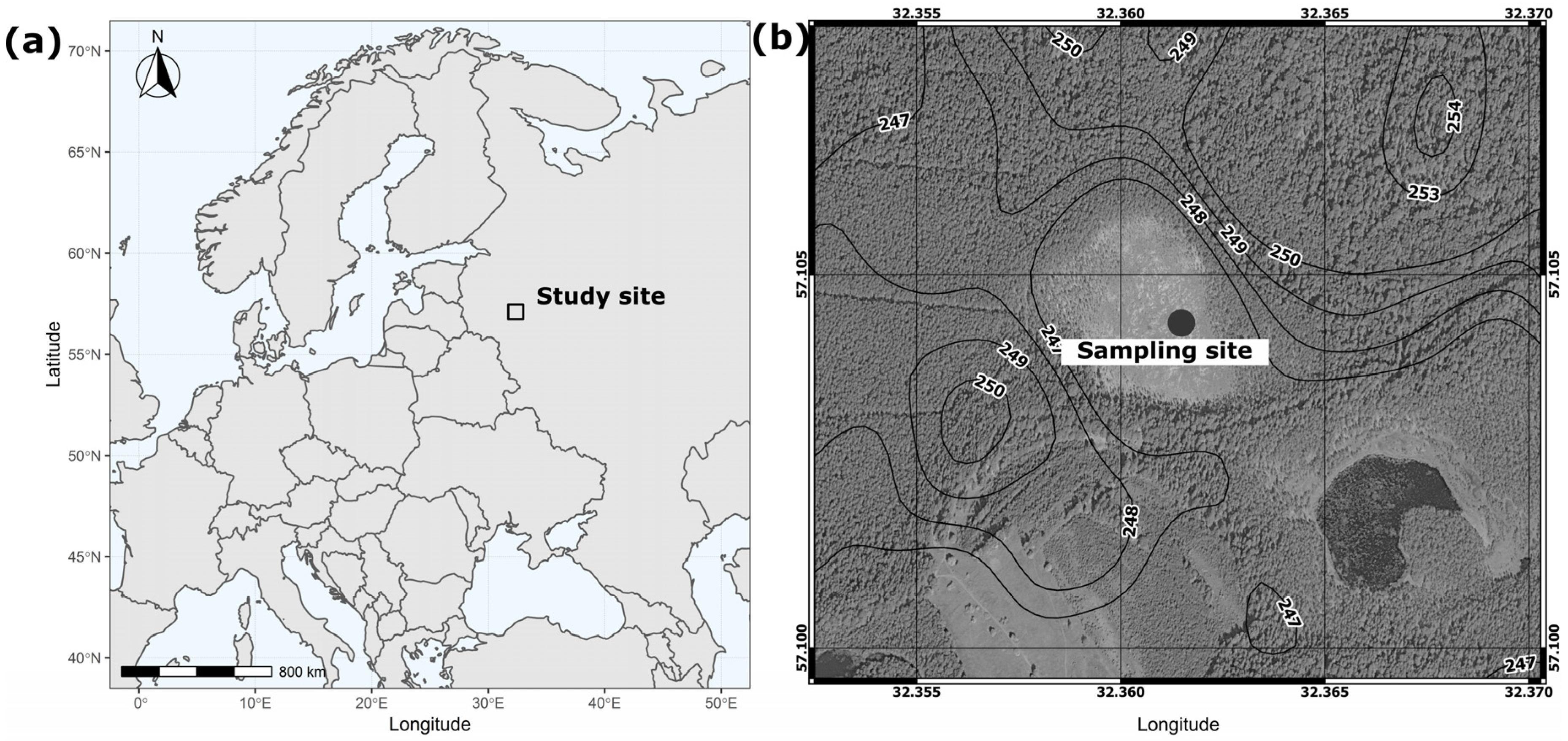
2.2. Analytical Methodology
2.2.1. Reconstruction of Humification, WTD and Temperature Timeseries
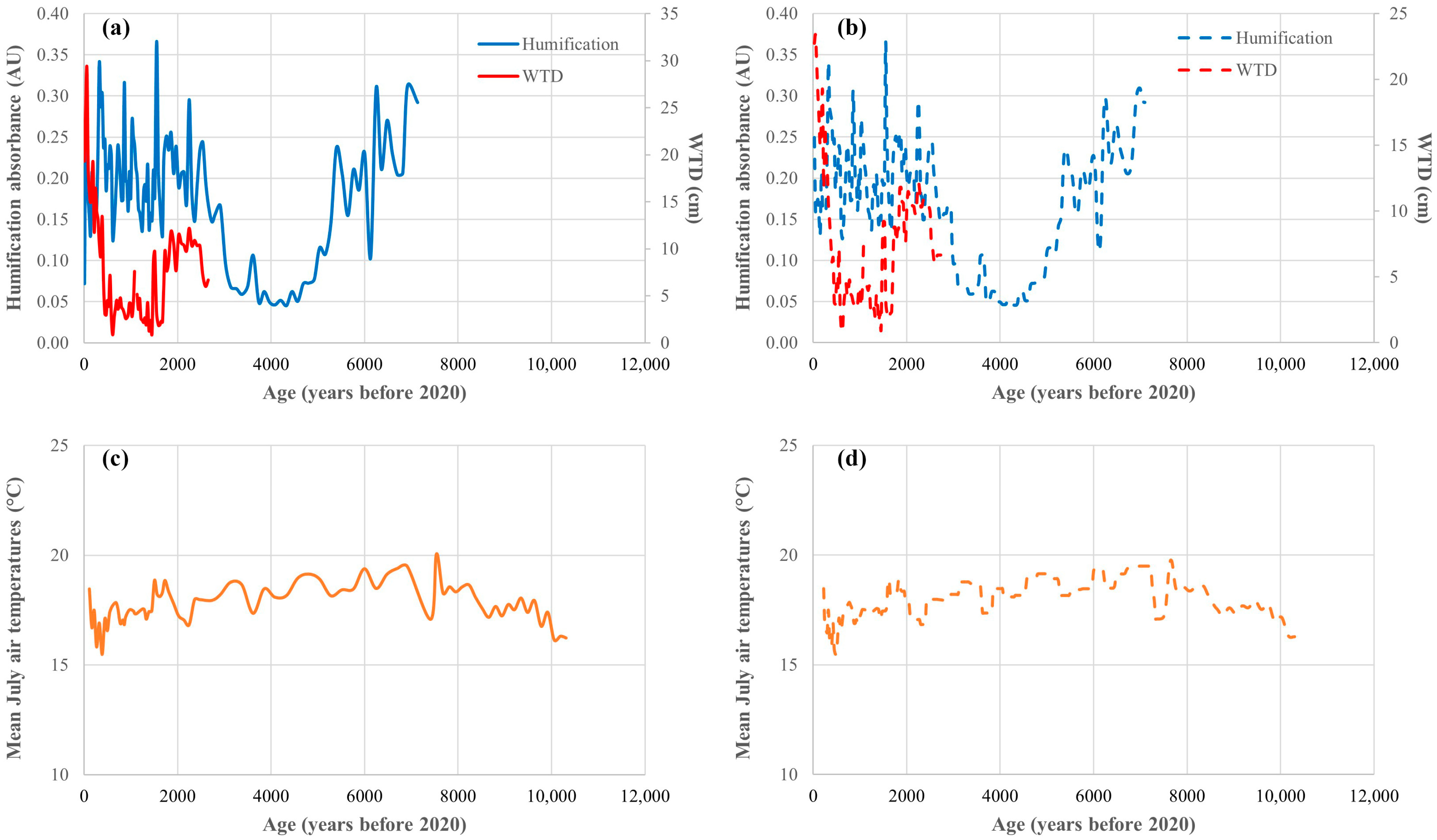
2.2.2. Search for Memory Effects in Humification Data
2.2.3. Ensemble Empirical Mode Decomposition (EEMD) Analysis
3. Results and Discussion
3.1. Non-Linearity in Reconstructed Humification Timeseries
- First, the spectral density must be better described by the power-law than the exponential fitting. As can be seen in Figure 3b, this criterion is met.
- Second, the local slopes of logFd(τ) vs. logτ (calculated for a 10-point window and a 9-point window) must be stable to a sufficient range. To this aim, Monte Carlo simulations were performed by applying the DFA method in 500 timeseries characterized by fractional Gaussian noise (with α = 1.07) in order to calculate the local slopes-α (τ) for each of them, accompanied by the corresponding 2σ intervals. Thus, according to Figure 3c, all local slopes (after the scale logτ = 1.18) are within the range, indicating sufficient stability. Therefore, the second criterion is also met.
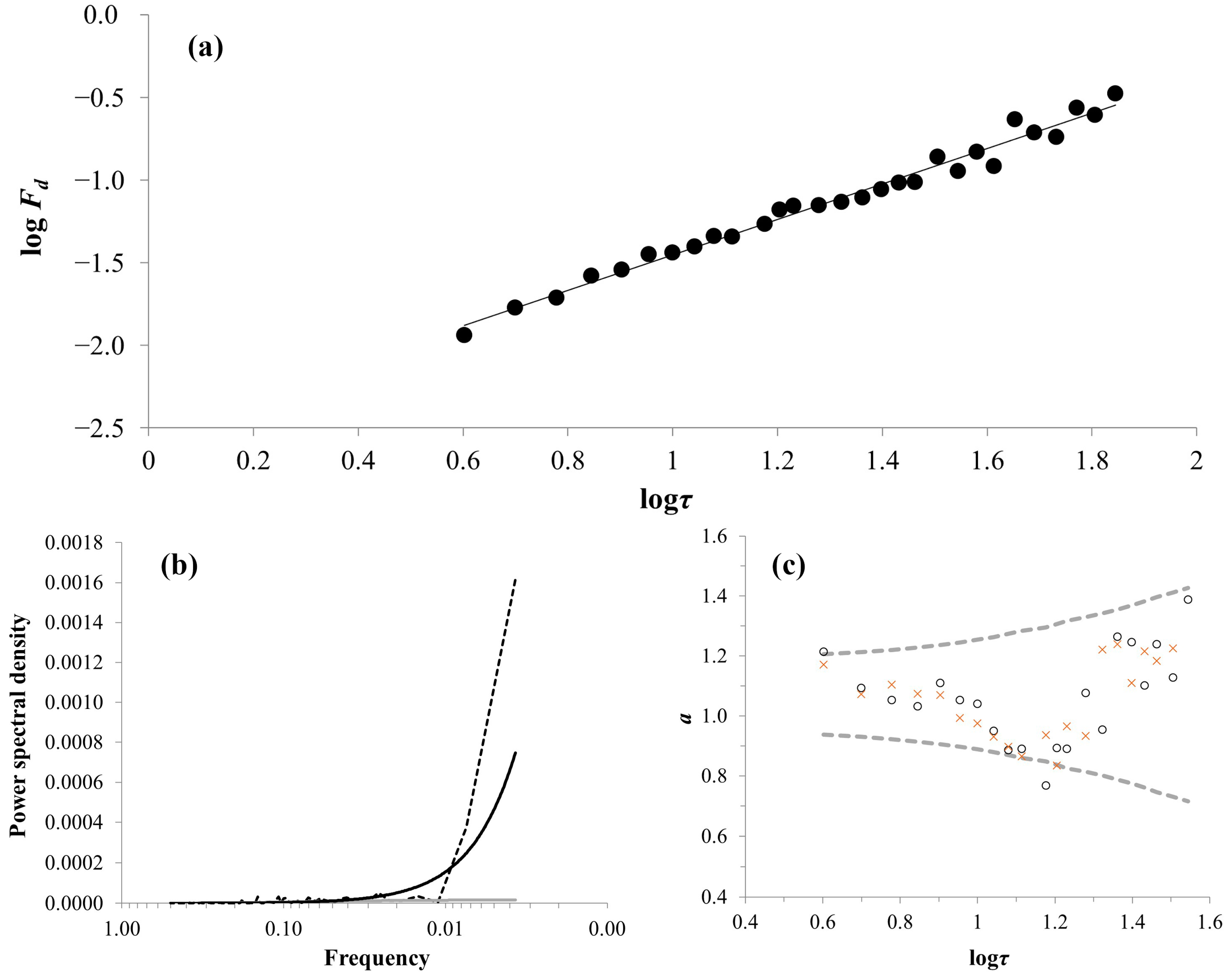
3.2. Non-Linearity in Detrended Reconstructed Humification Timeseries
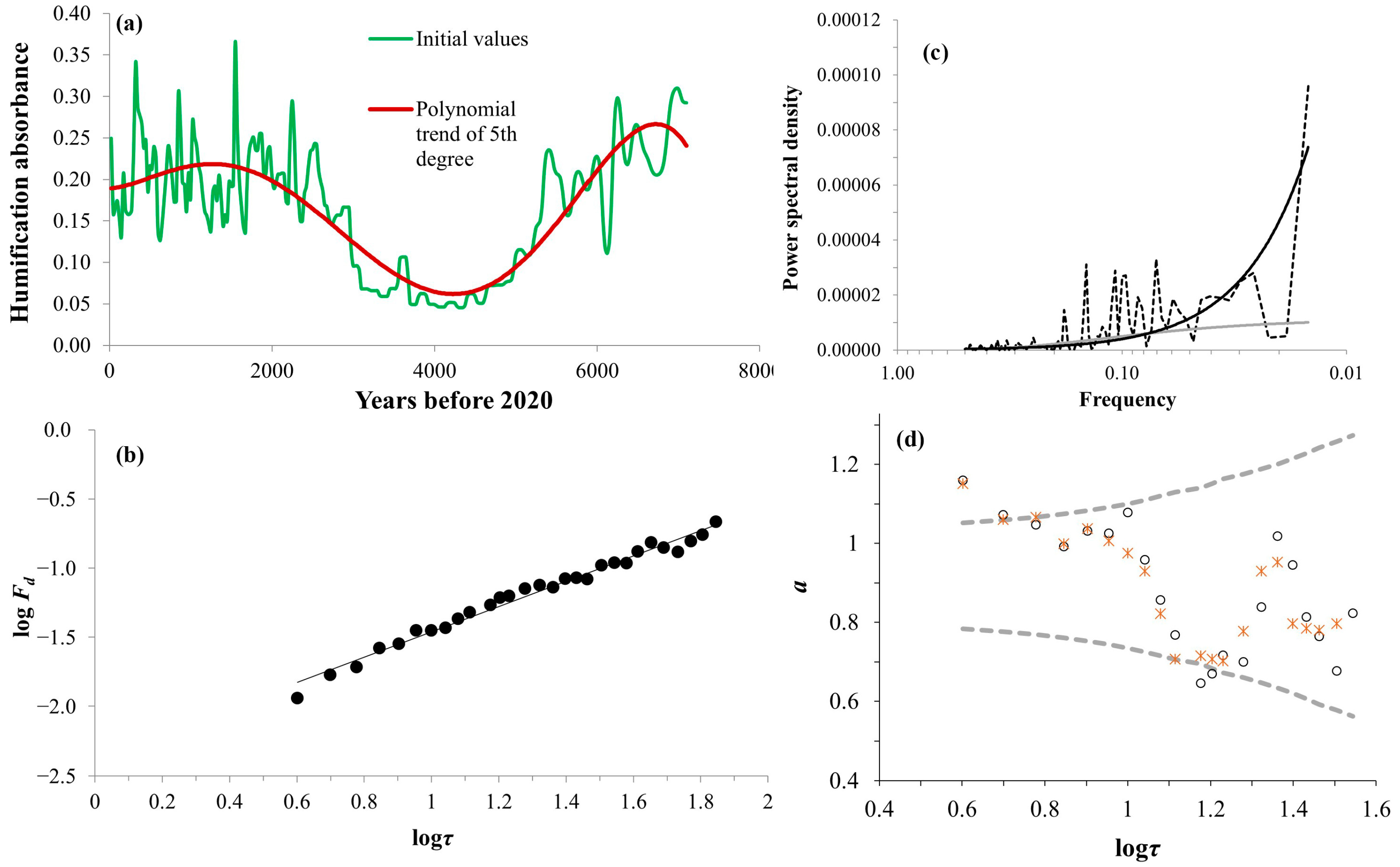

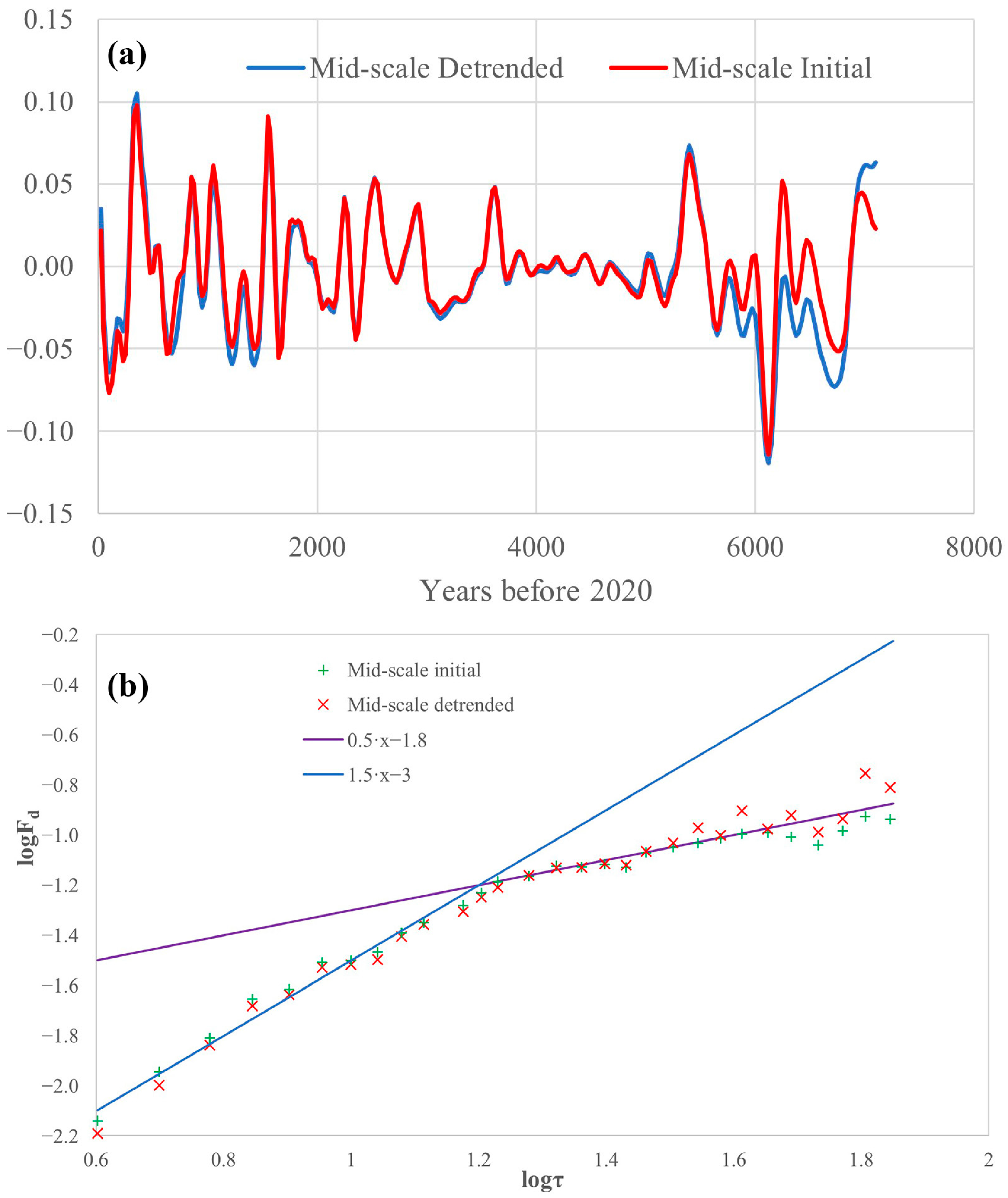
3.3. Non-Linearity in Deseasonalized and Detrended Reconstructed Water Table Depth and Temperature Timeseries
4. Conclusions
Author Contributions
Funding
Institutional Review Board Statement
Informed Consent Statement
Data Availability Statement
Conflicts of Interest
References
- Fordham, D.A.; Jackson, S.T.; Brown, S.C.; Huntley, B.; Brook, B.W.; Dahl-Jensen, D.; Gilbert, M.T.P.; Otto-Bliesner, B.L.; Svensson, A.; Theodoridis, S.; et al. Using Paleo-Archives to Safeguard Biodiversity under Climate Change. Science 2020, 369, eabc5654. [Google Scholar] [CrossRef]
- Varotsos, C.; Mazei, Y.; Efstathiou, M. Paleoecological and Recent Data Show a Steady Temporal Evolution of Carbon Dioxide and Temperature. Atmos. Pollut. Res. 2020, 11, 714–722. [Google Scholar] [CrossRef]
- Black, B.A.; Andersson, C.; Butler, P.G.; Carroll, M.L.; DeLong, K.L.; Reynolds, D.J.; Schöne, B.R.; Scourse, J.; van der Sleen, P.; Wanamaker, A.D.; et al. The Revolution of Crossdating in Marine Palaeoecology and Palaeoclimatology. Biol. Lett. 2019, 15, 20180665. [Google Scholar] [CrossRef] [PubMed]
- Christodoulakis, J. Paleoenvironmental Reconstruction of Southwestern Peloponnesus Using Luminescence Dating Techniques. Anc. TL 2018, 36, 12. [Google Scholar]
- Tsakalos, E.; Athanassas, C.; Tsipas, P.; Triantaphyllou, M.; Geraga, M.; Papatheodorou, G.; Filippaki, E.; Christodoulakis, J.; Kazantzaki, M. Luminescence Geochronology and Paleoenvironmental Implications of Coastal Deposits of Southeast Cyprus. Archaeol. Anthr. Sci. 2018, 10, 41–60. [Google Scholar] [CrossRef]
- Cracknell, A.P.; Varotsos, C.A. New Aspects of Global Climate-Dynamics Research and Remote Sensing. Int. J. Remote Sens. 2011, 32, 579–600. [Google Scholar] [CrossRef]
- Mazei, Y.A.; Tsyganov, A.N.; Bobrovsky, M.V.; Mazei, N.G.; Kupriyanov, D.A.; Gałka, M.; Rostanets, D.V.; Khazanova, K.P.; Stoiko, T.G.; Pastukhova, Y.A.; et al. Peatland Development, Vegetation History, Climate Change and Human Activity in the Valdai Uplands (Central European Russia) during the Holocene: A Multi-Proxy Palaeoecological Study. Diversity 2020, 12, 462. [Google Scholar] [CrossRef]
- Bourgault, M.-A.; Larocque, M.; Garneau, M.; Roux, M. Quantifying Peat Hydrodynamic Properties and Their Influence on Water Table Depths in Peatlands of Southern Quebec (Canada): Hydrodynamic Properties of Peatlands and Their Influence on Water Table Depths. Ecohydrology 2018, 11, e1976. [Google Scholar] [CrossRef]
- Taufik, M.; Veldhuizen, A.A.; Wösten, J.H.M.; van Lanen, H.A.J. Exploration of the Importance of Physical Properties of Indonesian Peatlands to Assess Critical Groundwater Table Depths, Associated Drought and Fire Hazard. Geoderma 2019, 347, 160–169. [Google Scholar] [CrossRef]
- Mahdiyasa, A.W.; Large, D.J.; Muljadi, B.P.; Icardi, M.; Triantafyllou, S. MPeat—A Fully Coupled Mechanical-ecohydrological Model of Peatland Development. Ecohydrology 2022, 15, e2361. [Google Scholar] [CrossRef]
- Payne, R.J.; Blackford, J.J. Peat Humification and Climate Change: A Multi-Site Comparison from Mires in South-East Alaska. Mires Peat 2008, 11, 1–11. [Google Scholar]
- Tfaily, M.M.; Cooper, W.T.; Kostka, J.E.; Chanton, P.R.; Schadt, C.W.; Hanson, P.J.; Iversen, C.M.; Chanton, J.P. Organic Matter Transformation in the Peat Column at Marcell Experimental Forest: Humification and Vertical Stratification: Organic Matter Dynamics. J. Geophys. Res. Biogeosci. 2014, 119, 661–675. [Google Scholar] [CrossRef]
- Efstathiou, M.N.; Varotsos, C.A. Intrinsic Properties of Sahel Precipitation Anomalies and Rainfall. Appl. Clim. 2012, 109, 627–633. [Google Scholar] [CrossRef]
- Snyder, C.W. Evolution of Global Temperature over the Past Two Million Years. Nature 2016, 538, 226–228. [Google Scholar] [CrossRef] [PubMed]
- Varotsos, C.; Efstathiou, M.; Tzanis, C. Scaling Behaviour of the Global Tropopause. Atmos. Chem. Phys. 2009, 7, 677–683. [Google Scholar] [CrossRef] [Green Version]
- Varotsos, C.A.; Lovejoy, S.; Sarlis, N.V.; Tzanis, C.G.; Efstathiou, M.N. On the Scaling of the Solar Incident Flux. Atmos. Chem. Phys. 2015, 15, 7301–7306. [Google Scholar] [CrossRef] [Green Version]
- Varotsos, C.A.; Mazei, Y.A.; Burkovsky, I.; Efstathiou, M.N.; Tzanis, C.G. Climate Scaling Behaviour in the Dynamics of the Marine Interstitial Ciliate Community. Appl. Clim. 2016, 125, 439–447. [Google Scholar] [CrossRef]
- Varotsos, C.A.; Sarlis, N.V.; Efstathiou, M. On the Association between the Recent Episode of the Quasi-Biennial Oscillation and the Strong El Niño Event. Appl. Clim. 2018, 133, 569–577. [Google Scholar] [CrossRef]
- Varotsos, C.; Mazei, Y.; Novenko, E.; Tsyganov, A.N.; Olchev, A.; Pampura, T.; Mazei, N.; Fatynina, Y.; Saldaev, D.; Efstathiou, M. A New Climate Nowcasting Tool Based on Paleoclimatic Data. Sustainability 2020, 12, 5546. [Google Scholar] [CrossRef]
- Varotsos, C.A.; Mazei, Y.; Saldaev, D.; Efstathiou, M.; Voronova, T.; Xue, Y. Nowcasting of Air Pollution Episodes in Megacities: A Case Study for Athens, Greece. Atmos. Pollut. Res. 2021, 12, 101099. [Google Scholar] [CrossRef]
- Blaauw, M.; Christen, J.A. Rbacon: Age-Depth Modelling Using Bayesian Statistics; R Package Version 2.3.5; R Foundation for Statistical Computing: Vienna, Austria, 2020; Available online: https://CRAN.R-project.org/package=rbacon (accessed on 28 October 2020).
- Chambers, F.M.; Beilman, D.W.; Yu, Z. Methods for Determining Peat Humification and for Quantifying Peat Bulk Density. Org. Matter Carbon Content Palaeostudies Clim. Peatl. Carbon Dyn. 2011, 7, 1–10. [Google Scholar]
- Tsyganov, A.N.; Babeshko, K.V.; Novenko, E.Y.; Malysheva, E.A.; Payne, R.J.; Mazei, Y.A. Quantitative Reconstruction of Peatland Hydrological Regime with Fossil Testate Amoebae Communities. Russ. J. Ecol. 2017, 48, 191–198. [Google Scholar] [CrossRef]
- Salonen, J.S.; Korpela, M.; Williams, J.W.; Luoto, M. Machine-Learning Based Reconstructions of Primary and Secondary Climate Variables from North American and European Fossil Pollen Data. Sci. Rep. 2019, 9, 15805. [Google Scholar] [CrossRef] [PubMed]
- Helske, J.; Luukko, P. R Package ‘Rlibeemd’; R Foundation for Statistical Computing: Vienna, Austria, 2021. [Google Scholar]
- Wiener, N. Extrapolation, Interpolation and Smoothing of Stationary Time Series; John Wiley: New York, NY, USA, 1949; pp. 1–163. ISBN 978-0-262-23002-5. [Google Scholar]
- Weber, R.O.; Talkner, P. Spectra and Correlations of Climate Data from Days to Decades. J. Geophys. Res. 2001, 106, 20131–20144. [Google Scholar] [CrossRef] [Green Version]
- Wu, Z.; Huang, N.E. Ensemble empirical mode decomposition: A noise-assisted data analysis method. Adv. Adapt. Data Anal. 2009, 1, 1–41. [Google Scholar] [CrossRef]
- Huang, N.E.; Shen, Z.; Long, S.R.; Wu, M.C.; Shih, H.H.; Zheng, Q.; Yen, N.-C.; Tung, C.C.; Liu, H.H. The Empirical Mode Decomposition and the Hilbert Spectrum for Nonlinear and Non-Stationary Time Series Analysis. Proc. R. Soc. Lond. A 1998, 454, 903–995. [Google Scholar] [CrossRef]
- Huang, N.E.; Wu, M.-L.; Qu, W.; Long, S.R.; Shen, S.S.P. Applications of Hilbert-Huang Transform to Non-Stationary Financial Time Series Analysis. Appl. Stoch. Models Bus. Ind. 2003, 19, 245–268. [Google Scholar] [CrossRef]
- Yang, J.N.; Lei, Y.; Lin, S.; Huang, N. Hilbert-Huang Based Approach for Structural Damage Detection. J. Eng. Mech. 2004, 130, 85–95. [Google Scholar] [CrossRef]
- Xie, H.; Wang, Z. Mean Frequency Derived via Hilbert-Huang Transform with Application to Fatigue EMG Signal Analysis. Comput. Methods Programs Biomed. 2006, 82, 114–120. [Google Scholar] [CrossRef]
- Bowman, D.C.; Lees, J.M. The Hilbert-Huang Transform: A High Resolution Spectral Method for Nonlinear and Nonstationary Time Series. Seismol. Res. Lett. 2013, 84, 1074–1080. [Google Scholar] [CrossRef]
- Wang, Y.-H.; Yeh, C.-H.; Young, H.-W.V.; Hu, K.; Lo, M.-T. On the Computational Complexity of the Empirical Mode Decomposition Algorithm. Phys. A Stat. Mech. Appl. 2014, 400, 159–167. [Google Scholar] [CrossRef]
- Sarlis, N.V.; Skordas, E.S.; Mintzelas, A.; Papadopoulou, K.A. Micro-Scale, Mid-Scale, and Macro-Scale in Global Seismicity Identified by Empirical Mode Decomposition and Their Multifractal Characteristics. Sci. Rep. 2018, 8, 9206. [Google Scholar] [CrossRef]
- Luukko, P.J.J.; Helske, J.; Räsänen, E. Introducing Libeemd: A Program Package for Performing the Ensemble Empirical Mode Decomposition. Comput. Stat. 2016, 31, 545–557. [Google Scholar] [CrossRef] [Green Version]
- Maraun, D.; Rust, H.W.; Timmer, J. Tempting Long-Memory—on the Interpretation of DFA Results. Nonlin. Process. Geophys. 2004, 11, 495–503. [Google Scholar] [CrossRef] [Green Version]
- Xapsos, M.A.; Burke, E.A. Evidence of 6 000-Year Periodicity in Reconstructed Sunspot Numbers. Sol. Phys. 2009, 257, 363–369. [Google Scholar] [CrossRef] [Green Version]
- Johnson, J.B. The Schottky Effect in Low Frequency Circuits. Phys. Rev. 1925, 26, 71–85. [Google Scholar] [CrossRef]
- Bak, P.; Tang, C.; Wiesenfeld, K. Self-Organized Criticality: An Explanation of the 1/f Noise. Phys. Rev. Lett. 1987, 59, 381–384. [Google Scholar] [CrossRef]
- Bak, P.; Tang, C.; Wiesenfeld, K. Self-Organized Criticality. Phys. Rev. A 1988, 38, 364–374. [Google Scholar] [CrossRef]
- Alm, J. CO2 and CH4 Fluxes and Carbon Balance in the Atmospheric Interaction of Boreal Peatlands. Ph.D. Thesis, Yliopiston Luonnontieteellisiä Julkaisuja, University of Joensuu, Joensuu, Finland, 15 December 1997. [Google Scholar]
- Belyea, L.R. Nonlinear dynamics of peatlands and potential feedbacks on the climate system. In Geophysical Monograph Series; Baird, A.J., Belyea, L.R., Comas, X., Reeve, A.S., Slater, L.D., Eds.; American Geophysical Union: Washington, DC, USA, 2013; pp. 5–18. ISBN 978-1-118-66666-1. [Google Scholar]
- Allan, R.P.; Cassou, C.; Chen, D.; Cherchi, A.; Connors, L.; Doblas-Reyes, F.J.; Douville, H.; Driouech, F.; Edwards, T.L.; Fischer, E.; et al. Summary for policymakers. In Climate Change 2021: The Physical Science Basis. Contribution of Working Group I to the Sixth Assessment Report of the Intergovernmental Panel on Climate Change; Cambridge University Press: Cambridge, UK, 2021; p. 32. [Google Scholar]
- Ratcliffe, J.L.; Campbell, D.I.; Schipper, L.A.; Wall, A.M.; Clarkson, B.R. Recovery of the CO2 Sink in a Remnant Peatland Following Water Table Lowering. Sci. Total Environ. 2020, 718, 134613. [Google Scholar] [CrossRef]
- Weiss, R.; Shurpali, N.J.; Sallantaus, T.; Laiho, R.; Laine, J.; Alm, J. Simulation of Water Table Level and Peat Temperatures in Boreal Peatlands. Ecol. Model. 2006, 192, 441–456. [Google Scholar] [CrossRef]
- Waddington, J.M.; Morris, P.J.; Kettridge, N.; Granath, G.; Thompson, D.K.; Moore, P.A. Hydrological Feedbacks in Northern Peatlands: Hydrological feedbacks in northern peatlands. Ecohydrology 2015, 8, 113–127. [Google Scholar] [CrossRef]
- Frolking, S.; Roulet, N.T.; Tuittila, E.; Bubier, J.L.; Quillet, A.; Talbot, J.; Richard, P.J.H. A New Model of Holocene Peatland Net Primary Production, Decomposition, Water Balance, and Peat Accumulation. Earth Syst. Dynam. 2010, 1, 1–21. [Google Scholar] [CrossRef] [Green Version]
- Lovejoy, S.; Schertzer, D. Haar Wavelets, Fluctuations and Structure Functions: Convenient Choices for Geophysics. Nonlin. Process. Geophys. 2012, 19, 513–527. [Google Scholar] [CrossRef] [Green Version]
- Lovejoy, S.; Schertzer, D. Stochastic and Scaling Climate Sensitivities: Solar, Volcanic and Orbital Forcings: Stochastic climate sensitivities. Geophys. Res. Lett. 2012, 39, L051871. [Google Scholar] [CrossRef] [Green Version]
- Liu, T.; Luo, Z.; Huang, J.; Yan, S. A Comparative Study of Four Kinds of Adaptive Decomposition Algorithms and Their Applications. Sensors 2018, 18, 2120. [Google Scholar] [CrossRef] [Green Version]
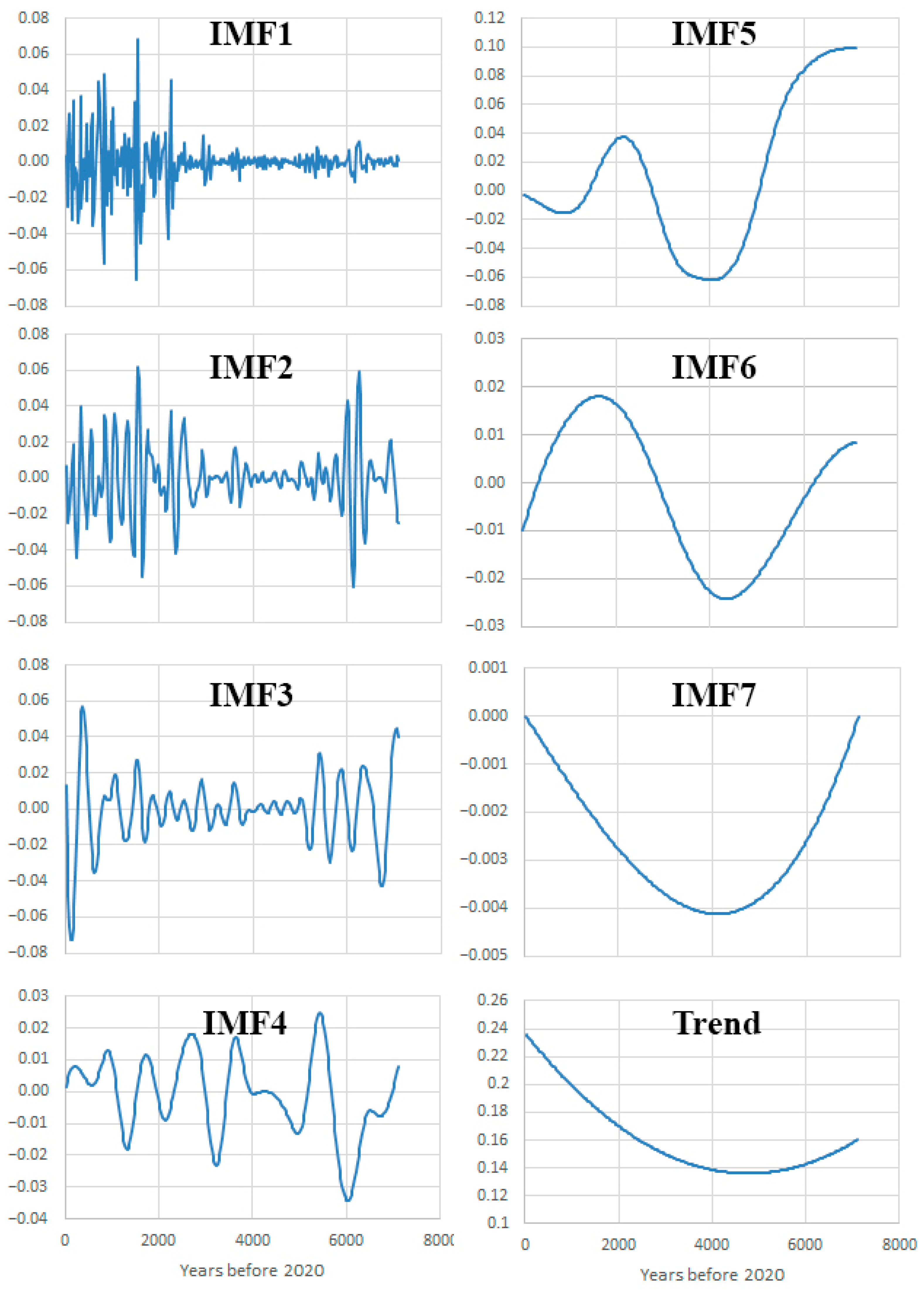

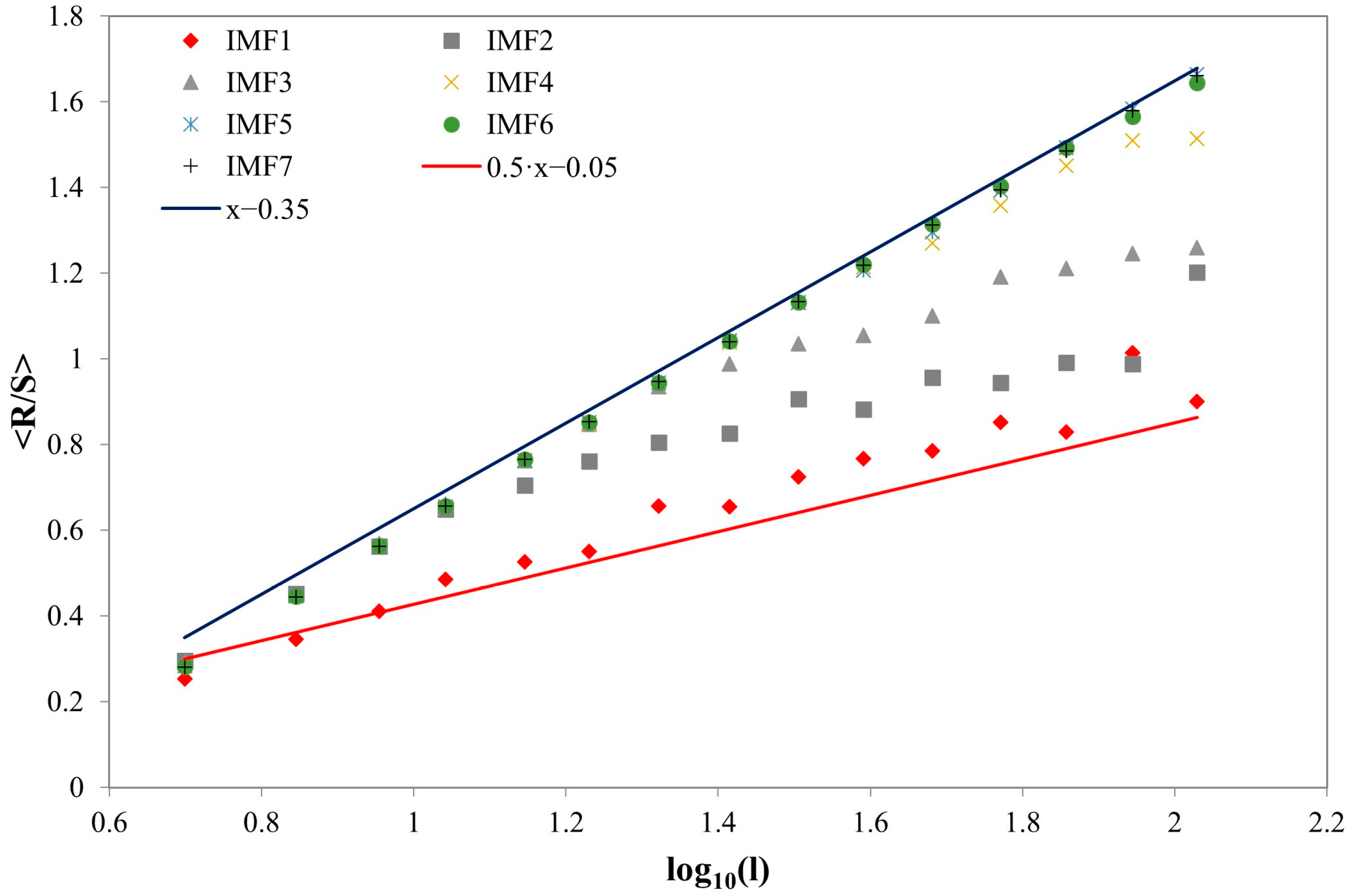

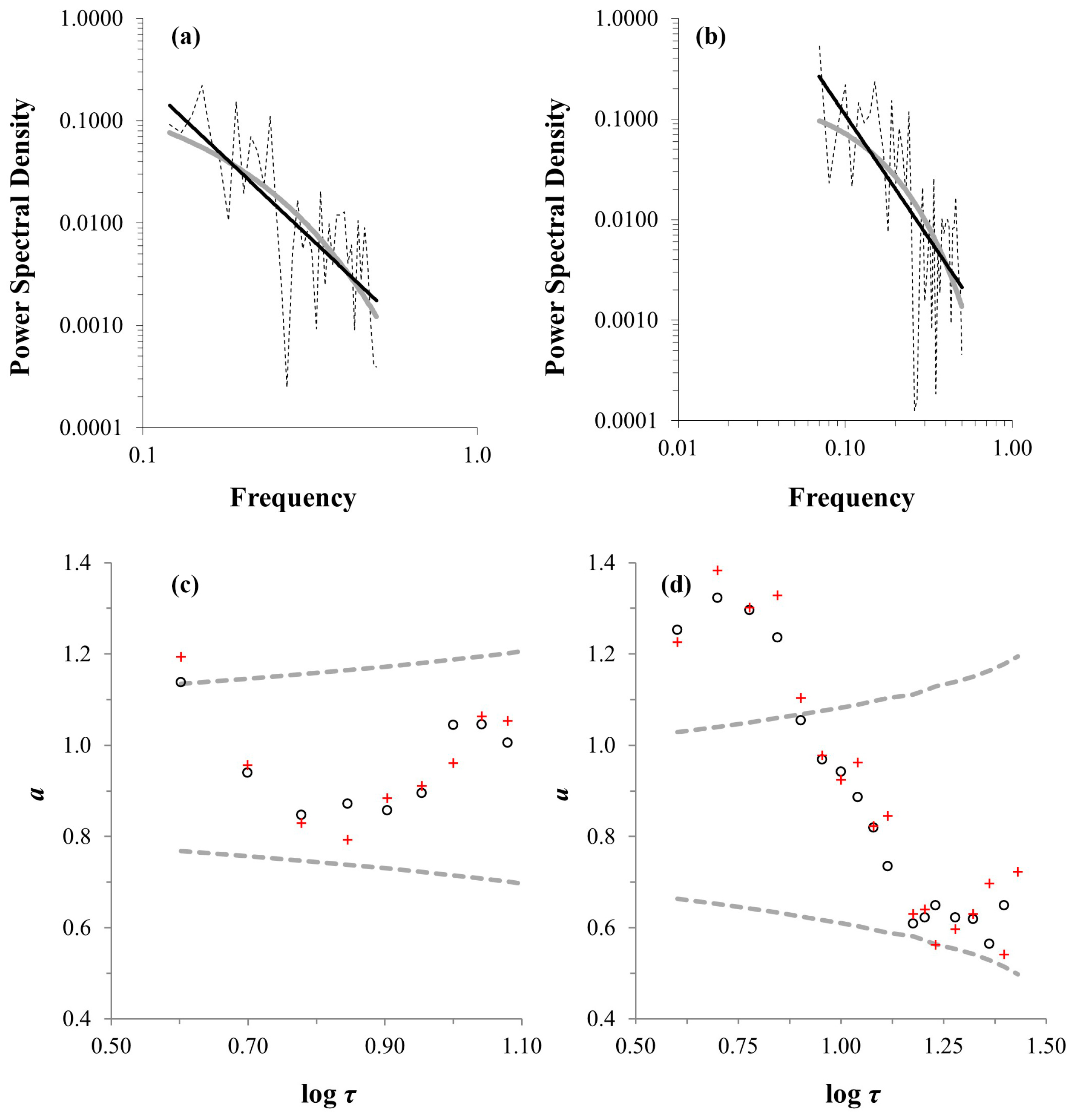

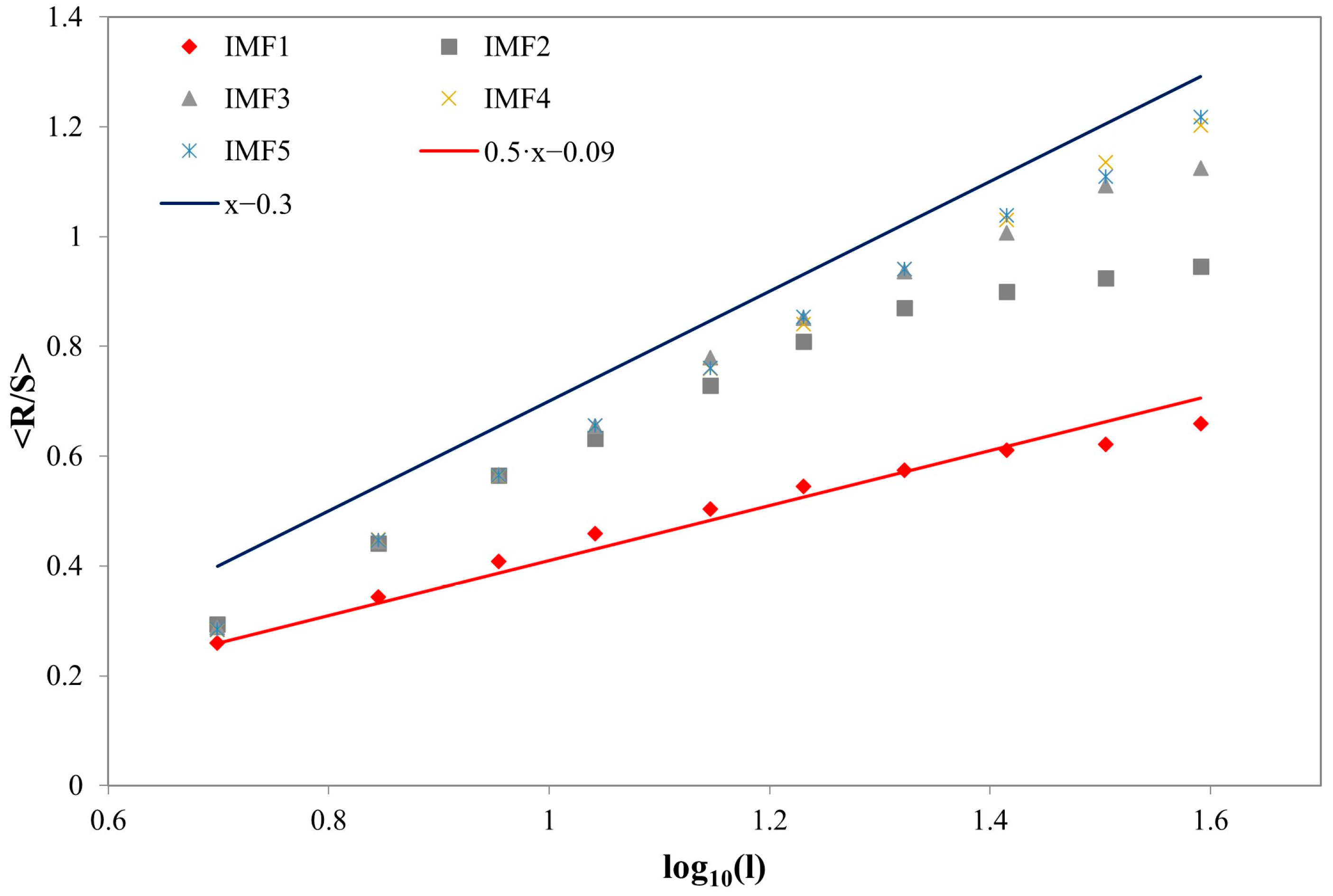

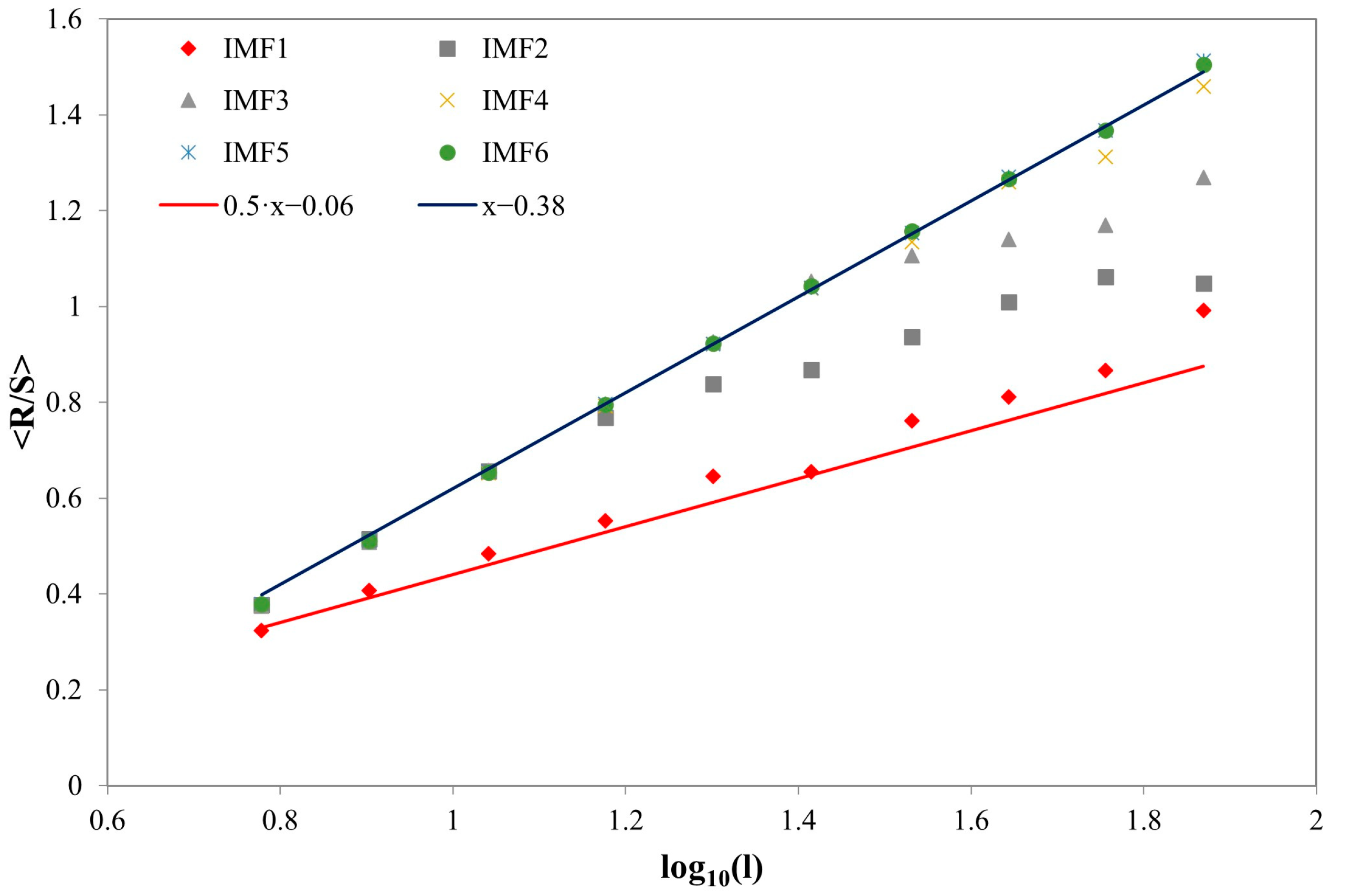
Publisher’s Note: MDPI stays neutral with regard to jurisdictional claims in published maps and institutional affiliations. |
© 2022 by the authors. Licensee MDPI, Basel, Switzerland. This article is an open access article distributed under the terms and conditions of the Creative Commons Attribution (CC BY) license (https://creativecommons.org/licenses/by/4.0/).
Share and Cite
Fotaki, E.-F.; Christodoulakis, J.; Efstathiou, M.; Tsyganov, A.N.; Mazei, Y.; Mazei, N.G.; Saldaev, D.; Sarlis, N.V.; Varotsos, C.; Voronova, T. Scaling Behavior of Peat Properties during the Holocene: A Case Study from Central European Russia. Land 2022, 11, 862. https://doi.org/10.3390/land11060862
Fotaki E-F, Christodoulakis J, Efstathiou M, Tsyganov AN, Mazei Y, Mazei NG, Saldaev D, Sarlis NV, Varotsos C, Voronova T. Scaling Behavior of Peat Properties during the Holocene: A Case Study from Central European Russia. Land. 2022; 11(6):862. https://doi.org/10.3390/land11060862
Chicago/Turabian StyleFotaki, Eleni-Foteini, John Christodoulakis, Maria Efstathiou, Andrey N. Tsyganov, Yuri Mazei, Natalia G. Mazei, Damir Saldaev, Nicholas V. Sarlis, Costas Varotsos, and Tatiana Voronova. 2022. "Scaling Behavior of Peat Properties during the Holocene: A Case Study from Central European Russia" Land 11, no. 6: 862. https://doi.org/10.3390/land11060862
APA StyleFotaki, E.-F., Christodoulakis, J., Efstathiou, M., Tsyganov, A. N., Mazei, Y., Mazei, N. G., Saldaev, D., Sarlis, N. V., Varotsos, C., & Voronova, T. (2022). Scaling Behavior of Peat Properties during the Holocene: A Case Study from Central European Russia. Land, 11(6), 862. https://doi.org/10.3390/land11060862









